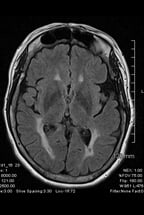Although the cause of Multiple Sclerosis (MS) is unknown ongoing research is moving forward at a remarkable pace and more potential therapies appear to be in the pipeline than ever before.
MS affects the brain and spinal cord in 2.5 million people worldwide. Approximately 300,000 fellow Americans suffer from this potentially debilitating disorder. Common symptoms include blurred vision, loss of balance, numbness and weakness. Disease progression is variable and approximately 50% of those affected by MS will have some degree of mental impairment; however, 50% may not.
Americans suffer from this potentially debilitating disorder. Common symptoms include blurred vision, loss of balance, numbness and weakness. Disease progression is variable and approximately 50% of those affected by MS will have some degree of mental impairment; however, 50% may not.
The cause of multiple sclerosis is unknown. Symptoms result when the protective myelin sheath surrounding nerve cells is destroyed by the body’s immune system. The disease, more common in women, usually occurs in adults between the ages of 20 and 40. For reasons still unclear to us multiple sclerosis (MS) is more common for those living in northern regions such as the Northern United States, Canada and the Scandinavian countries. While genetic and environmental factors may play a role, MS is more common in Caucasians than those of Asian or African descent. People with first-degree relatives (parent, sibling, or child) with MS are 20 times more likely to develop the disease than those without a positive family history. If an identical twin develops MS, there is a 30% chance the other twin will get the disease.
Treatment and Management of Symptoms:
While there is currently no cure, drugs such as steroids, interferons, immunomodulators and immunosuppressant agents have variable results. Acute attacks of MS are typically managed by high-dose steroids and can be effective short-term options for relieving symptoms. Disease modifying agents such as interferons or immunomodulators can be helpful in reducing the progression of the disease.
The benefit of MRI for MS:
 Although MS is primarily a clinical diagnosis, MRI (magnetic resonance imaging) is extremely important and a progressive way of diagnosing and monitoring the disease. MRI has had a major impact in confirming the diagnosis of MS. In MS patients , brain MRI scans will show characteristic findings in greater than 95% of imaged MS patients. Spinal cord abnormalities for those with MS will be seen with 75-85% accuracy. Some patients with MS may only be diagnosed with spinal cord lesions through an MRI scan. The MRI findings of MS in the brain include areas of bright signal next to the ventricles as well as involvement of the corpus callosum. Intravenous contrast agents can help distinguish active from inactive lesions and help determine if drug therapy is working. Spinal cord lesions show up as areas of bright signal. Acute or active spinal cord lesions may show swelling and enhancement with contrast.
Although MS is primarily a clinical diagnosis, MRI (magnetic resonance imaging) is extremely important and a progressive way of diagnosing and monitoring the disease. MRI has had a major impact in confirming the diagnosis of MS. In MS patients , brain MRI scans will show characteristic findings in greater than 95% of imaged MS patients. Spinal cord abnormalities for those with MS will be seen with 75-85% accuracy. Some patients with MS may only be diagnosed with spinal cord lesions through an MRI scan. The MRI findings of MS in the brain include areas of bright signal next to the ventricles as well as involvement of the corpus callosum. Intravenous contrast agents can help distinguish active from inactive lesions and help determine if drug therapy is working. Spinal cord lesions show up as areas of bright signal. Acute or active spinal cord lesions may show swelling and enhancement with contrast.
Advances in MRI such as 3D imaging with a slice thickness of 1mm have increased sensitivity and accuracy in the diagnosis of MS. Thus, MRI is a tool to aid in the accuracy of the diagnosis as well as evaluating and pacing the impact of a course of treatment for an MS patient.
As research advances and promising therapies are made available MS patients have additional resources and support groups including national and local chapters of the MS society. For more information we urge you to contact www.nationalmssociety.org.
Shields offers neurological MRI services at every location in our network.



